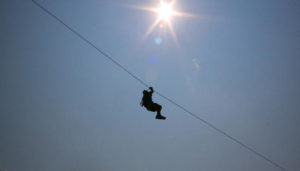
When I saw the zipline at Go Ape, my thoughts drifted back a century or so to the kids who lived on the south side of the Rocky River in Chatham County who had to get to school on the north side of the river. With no bridge for miles, someone strung a steel cable across the river, tied it off around some trees, then had the kids ride in a bucket across the river to school every morning, back home every afternoon.
I thought about those frigid January mornings riding in an ice bucket. I thought about those days after (or during) a heavy rain, when the roiling Rocky would have been nipping at their keisters. I thought about how this “zipline” was likely devoid of rigorous safety oversight — or any oversight at all.
And I thought about how those kids who rode in a bucket over the river to school every day likely went through life nonplussed by the challenges they faced, challenges that, compared to their commute, likely seemed pretty manageable.
Lessons learned from the past
Ziplines and high ropes courses have blossomed over the past few years. One estimate puts the number in the U.S. at 7,500, with 200 to 400 more built each year. Ziplines tend to sell adrenaline; facilities that weave ziplines into a high-ropes course take it up a notch: sure, there’s the adrenaline, but there’s also the psychological element. Here’s how the Jim Wall High Challenge Course at N.C. State (in Schenck Forest), which includes 15 high course elements 35 to 40 feet above ground, describes its mission:
“High course elements push participants to go beyond their perceived limits while working as an individual or as a team. Participants are challenged to expand their comfort zone, build self-confidence, and overcome self-imposed barriers, while being motivated and encouraged by other group members.”
In other words, the course aims to teach the lessons some kids once got simply by going to school.
I thought about this while standing on a small platform 35 feet in the air at Blue Jay Point County Park, home of Go Ape, the Triangle’s first open-to-the-public zipline/challenge course.
Going Ape
Go Ape has five stations. Enter a secured station — you access each fenced station after entering the pass code de jour — climb a ladder to a platform, head out on ropes challenges with such apropos appellations as Log Swing, Spider’s Web, Double Stirrups and Apple Picker’s Ladder, end each station zipping back to terra firma. Along the way are two Tarzan swings: swing from a cable into a cargo net. From the time you step foot off the ground, you are secured by at least two cables, sometimes three.
Sessions begin with a safety session, starting with properly fitting your harness and progressing to how (and when) to clip in to the safety lines, the zipline cables, the Tarzan swing. The safety session takes maybe 20 minutes; after that, I was surprised to find, you are on your own (instructors patrol the grounds, making sure you’re clipping in and offering advice when needed).
That you are essentially on your own is a bold thing in this day and age. The instruction is thorough and complete, but you must pay attention and you must do as directed.
In short, you must take responsibility. Being 35 feet in the air is good incentive.
Sense of self
You also must have a strong sense of self. Or have an interest in developing a sense of self. Getting on a plane and assuming a 60-ton tube of steel can stay aloft at 30,000 feet requires faith in others — from aerospace engineers, to mechanics to pilots and air traffic controllers. Stepping off a platform 40-feet up and trusting that a steel cable and your harness will keep you from crashing to the ground sooner than intended depends, in part, upon your trust in the folks running the facility. In the case of the zipline, though, you must take that first step, and in the case of the wobbly sky bridges and other high-rope challenges, the subsequent steps after that.
Are many people freaked out by that, I asked Go Ape Deputy Manager Josephine Bland.
“Not really,” she said, “because if you fall, you aren’t falling far.” A foot, maybe, before the double safety cables grab.
So most people are bold enough to try: that was the good news.
The not-so-good news came from my instructor, Cameron. He agreed that most people can handle the fear factor.
The one thing that will keep people from completing the course:
“They don’t have the physical strength to climb the cargo net after the Tarzan Swing.”
* * *
Like us on Facebook and get health, fitness and outdoors news throughout the day.
